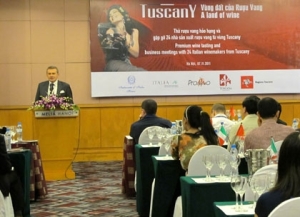How Export wine to South Korea? Export wine to South Korea. If You want to sell your wine in South Korea, you must know your competitors. You know already the habits of South Korean people, know you must learn about other wine producers and their figures in South Korea.
The main competitors are:
- France
- Chile
- Italuy
- Australia
- Spain
- Germany
 France: For many Koreans when they think about wine they just think in France wine. As a result, France has remained the leading supplier of wine to South Korea over the years. Total imports from France amounted to $16.7 million (1.5 million liters) in the first half of 2011, up 2 percent from the same period of 2010. However, the market share held by France has continued a decline since mid 2000‟s because French wine lost much of the ground in value- oriented product segments of the market to Chile and Italy. In volume, France has stepped down to the fourth largest supplier in the first half of 2011. France is focusing on higher price (quality) segments of the South Korean wine market in the next years
France: For many Koreans when they think about wine they just think in France wine. As a result, France has remained the leading supplier of wine to South Korea over the years. Total imports from France amounted to $16.7 million (1.5 million liters) in the first half of 2011, up 2 percent from the same period of 2010. However, the market share held by France has continued a decline since mid 2000‟s because French wine lost much of the ground in value- oriented product segments of the market to Chile and Italy. In volume, France has stepped down to the fourth largest supplier in the first half of 2011. France is focusing on higher price (quality) segments of the South Korean wine market in the next years
Chile: Total wine imports from Chile amounted to $15.1 million (3.3 million liters) in the first half of 2011, up 32.7 % from the same period of 2010. In particular, Chile has surpassed France for the first time to become the leading supplier in bottled red wine category, which is the single largest product category in South Korea’s wine imports. As a result, Chile‟s gap in overall market share to France was narrowed down to only 2.7 % point. Since 2008 if we speak in Volume Chile has become the leading supplier of wine to South Korea. After the Chile-South Korea Free Trade Agreement that went into effect in April 2004, Chilean wine started to rise. Under the agreement, the 15 percent import duty on Chilean wine was eliminated over a seven year period (the import duty was reduced down to zero on January 1, 2011).
 Italy: Total wine imports from Italy amounted to $10.4 million (2.0 million liters) in the first half of 2011, up 12 % from the same period of 2010. The popularity of the italian cuisine is going to be the base of Italian wine maintain in South Korea in the coming years. In particular, Italy has become the leading supplier of white wine to South Korea based on a huge success of Frizantte style product made from Moscato grapes, which targets the low-price level segment of the market.
Italy: Total wine imports from Italy amounted to $10.4 million (2.0 million liters) in the first half of 2011, up 12 % from the same period of 2010. The popularity of the italian cuisine is going to be the base of Italian wine maintain in South Korea in the coming years. In particular, Italy has become the leading supplier of white wine to South Korea based on a huge success of Frizantte style product made from Moscato grapes, which targets the low-price level segment of the market.
Australia: Total wine imports from Australia amounted to $4.1 million (0.6 million liters) in the first half of 2011, increasing 11 percent from the same period last year. Mainly due to a steep rise of the value of Australian dollar against other international currencies, Australian wine has shown a weak performance in South Korea over the last several years. Many of the products offered by Australian suppliers target value-oriented segments of the market and face steep competition against other new world competitors, including Chile and the United States. Implementation of South Korea-European Union Free Trade Agreement is another threat to the Australian suppliers.
 Spain: Total wine imports from Spain amounted to $4.0 million (2.6 million liters) in the first half of 2011, up 3.4 percent from the same period of 2010. Much of the wine imported from Spain was for local blending as indicated by the fact that Spain accounted for 70.5 percent and 82.1 percent of the bulk red and white wine (by volume) respectively imported into South Korea during the period.
Spain: Total wine imports from Spain amounted to $4.0 million (2.6 million liters) in the first half of 2011, up 3.4 percent from the same period of 2010. Much of the wine imported from Spain was for local blending as indicated by the fact that Spain accounted for 70.5 percent and 82.1 percent of the bulk red and white wine (by volume) respectively imported into South Korea during the period.
Germany: Total wine imports from Germany amounted to $1.1 million (0.2 million liters) in the first half of 2011, down 16.8 percent from the same period of 2010. Much of the German wine imported into South Korea was bottled white wine
Other Competitors: Overall wine imports from all minor suppliers combined, including Argentina, South Africa, and New Zealand, amounted to $2.7 million (0.6 million liters) in the first half of 2011, down 48.4 percent from the same period of 2010. It is interpreted that the consumers under economic pressure opted less for products from minor origins.
Export-oriented competitors are currently investing in many resources into marketing and promotional efforts in South Korea. Competitors‟ major marketing programs include: tasting seminars, paid-invitations of wine traders and press to overseas wine exhibitions, hosting cultural and culinary events incorporating wine components, supporting commercial consumer trips to wineries, exhibitions at local trade shows, supporting local wine schools with free samples and educational materials, and working closely with local wine experts including providing supports to Korean sommelier competitions.
Export Import. Wine South Korea. How to export wine to Care in the South? Red wine or White wine?Vino Export Exportar. Importar. Mercado del vino en Japon. Export – Import. Three mayor reason to export wine into South Korea. Export – Import. Opportunities in the Chinese Wine Industry . Exportation Export. Import. Wine Market Thailand. Market Sector Structure Export. Japan Wine market



